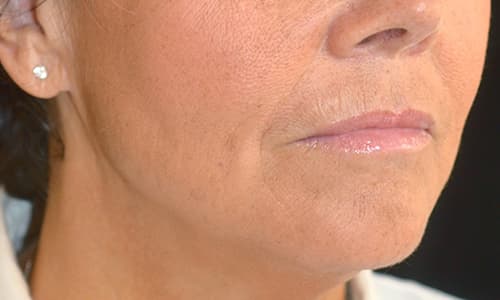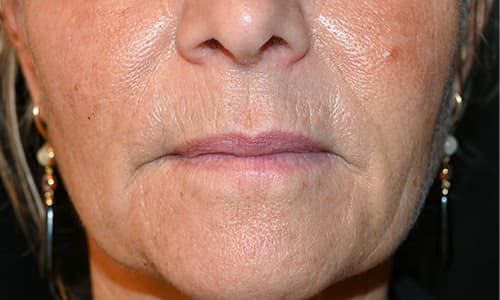
Target smile lines and nasolabial folds with advanced non surgical treatments at L’Atelier, Harley Street, London.
These lines form gradually and become more noticeable as the skin loses elasticity, volume and support. Over time, deeper folds can develop, giving the mid-face a heavier or more tired appearance even when you feel bright and rested.
At L’Atelier Aesthetics, we take a personalised and clinically led approach to treating smile lines. By assessing volume loss, skin laxity, collagen levels and the overall structure of the mid-face, we design a tailored plan that softens the folds, restores balance and enhances natural facial contours.


Smile lines develop when the deeper support structures of the mid-face begin to change. As we age, the fat pads shift, collagen decreases and the skin gradually becomes less firm. These changes create more visible creases between the nose and mouth.
Common reasons they appear include:
Loss of mid-face volume:
Reduced cheek support causes the fold to appear deeper.
Skin laxity:
As collagen and elastin decline, the skin becomes less able to stay lifted and smooth.
Changes in facial fat distribution:
Shifting fat pads can make the fold more defined.
Reduced hydration and skin thickness:
Thin skin can cause creases to appear more prominent.
Natural facial anatomy:
Some individuals have more defined smile lines from a young age.
Because everyone ages differently, smile lines vary in depth, shape and severity.
Smile lines form due to a combination of natural ageing and structural changes within the mid-face. As cheek volume decreases and the skin loses elasticity, the tissues around the nose and mouth begin to descend, deepening the fold. Hydration levels and genetics also play a role in how soon and how prominently these lines appear.
Understanding the exact cause allows us to choose the most effective and natural-looking treatment approach.




Every case of smile lines is unique. After your consultation, we will recommend the most suitable treatment or combination to soften the folds, restore support and improve the overall balance of the mid-face.
Juläine stimulates long-term collagen production in the mid-face.
It helps strengthen deeper structural support, making it a good option for smile lines caused by reduced elasticity or early tissue descent.
Morpheus8 uses radiofrequency microneedling to remodel collagen and tighten the mid-face.
It helps improve deeper, more etched-in smile lines and enhances the overall firmness of the skin.
Polynucleotides help strengthen the delicate skin around the nose and mouth.
They improve elasticity, hydration and collagen production, making them ideal for softening early smile lines or enhancing overall skin quality in this area.

Dermal fillers are the most effective treatment for deeper smile lines.
By restoring subtle volume and support in the mid-face, fillers help smooth the fold and lift the surrounding tissue, creating a fresher and more balanced appearance without overfilling.
Skin boosters deliver deep hydration and help improve the appearance of fine creasing around the fold.
They are especially effective for clients with early smile lines or those experiencing dryness or textural changes.
FaceTite is a minimally invasive treatment that uses radiofrequency-assisted contouring to tighten and lift sagging tissue.
It is suitable for clients with more significant laxity contributing to deep smile lines.
Smile lines form as the skin loses elasticity, mid-face volume decreases and deeper support structures begin to descend. Genetics, collagen decline and hydration levels all play a role in how early and how prominently they appear.
It depends on the depth and cause of the folds:
Dermal fillers for deeper or more established folds
Polynucleotides for strengthening and improving skin quality
Skin boosters for hydration and fine creases
Juläine® bio-stimulator for deeper collagen support
Morpheus8 for etched-in lines and mid-face tightening
Microneedling for surface texture and early folds
Sofwave for non-invasive tightening
FaceTite for moderate to severe laxity
Your clinician will recommend the ideal combination after assessing your facial structure.
Anti-wrinkle injections for prominent neck bands
Microneedling for surface texture
Your clinician will recommend the most appropriate combination.
No. While dermal fillers are highly effective for deeper folds, some clients benefit more from skin quality treatments, tightening devices or collagen-stimulating injectables. A personalised assessment determines the best option.
Your practitioner will outline a personalised plan.
Dermal fillers: 9–18 months
Polynucleotides: 6–12 months
Skin boosters: around 6 months
Juläine: up to 18 months
Morpheus8: 1–2 years
Sofwave: around 1 year
FaceTite: 1–3 years
Microneedling: cumulative results over a course
Maintenance treatments help prolong your results.
No. At L’Atelier, fillers are placed strategically to restore support rather than add bulk. The aim is to refresh the mid-face and soften the fold while keeping your natural facial contours intact.
Downtime varies depending on the treatment:
Fillers: minor swelling or redness for 24–48 hours
Morpheus8 / FaceTite: a few days of sensitivity or swelling
Sofwave: no downtime
Microneedling: pinkness for up to 48 hours
Polynucleotides / skin boosters: small bumps that settle quickly
Most clients return to normal activities on the same day or next day.
Smiling itself does not cause wrinkles .
The lines become more visible as structural support naturally declines with age. Treatments focus on restoring volume, elasticity and firmness without affecting your natural expressions.
Yes. Many clients achieve the best results using a combination such as filler & polynucleotides, Morpheus8 & skin boosters, or Sofwave & Juläine depending on their degree of laxity and skin quality.
At L’Atelier, we take a thoughtful and clinically led approach to treating smile lines, looking closely at the changes in skin elasticity, volume support and collagen structure that contribute to the depth of the folds. We also assess hydration levels, mid-face descent, skin quality and natural facial anatomy to understand exactly why the lines have formed and how they behave. With this detailed insight, we create a personalised treatment plan designed to restore support, soften the folds, improve texture and enhance the overall balance of the mid-face. Our aim is to achieve natural, subtle and long lasting rejuvenation while maintaining your unique facial expression and contours.
Dr Duncan Brennand is the Lead Aesthetic Physician at L’Atelier Aesthetics and has extensive experience in advanced injectable treatments, mid-face rejuvenation and collagen-stimulating therapies. He can specialise in assessing the underlying causes of smile lines, including volume loss, skin laxity and changes in facial structure, allowing him to tailor treatments with precision and natural-looking results.
With a deep understanding of facial anatomy and the dynamics of the mid-face, Dr Brennand carefully evaluates how the cheeks, skin quality and deeper support structures contribute to the depth of the folds. He combines treatments such as dermal fillers, polynucleotides, skin boosters, Morpheus8 and bio-stimulators to restore balance and soften smile lines without altering your natural expression. His personalised, clinically guided approach ensures subtle, refined and long lasting rejuvenation.


We are delighted to have over 200+ 5 star reviews. Your feedback is always important to us, as it helps us to improve our systems and processes in our continual pursuit of excellence. If you have any suggestions, comments, or concerns please get in touch.
Considering a dermal filler treatment? Learn more through our blog articles.